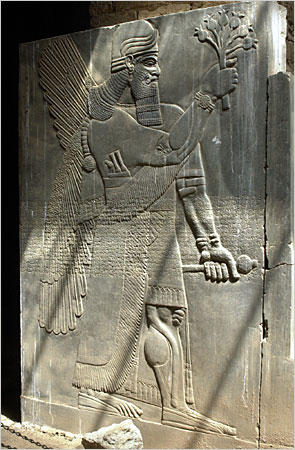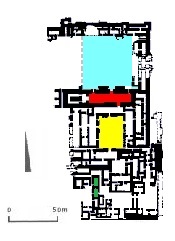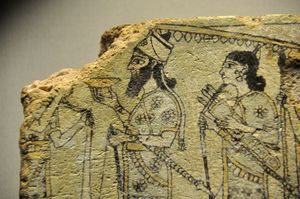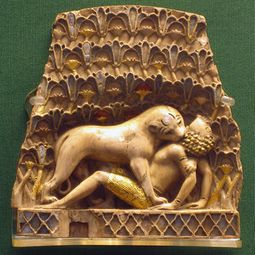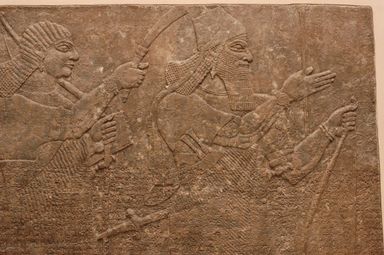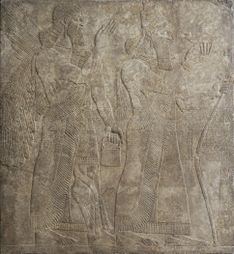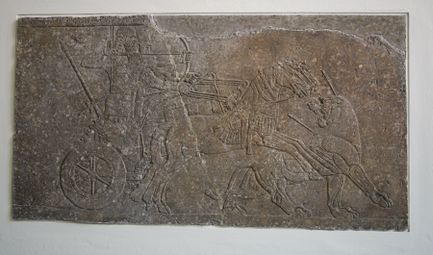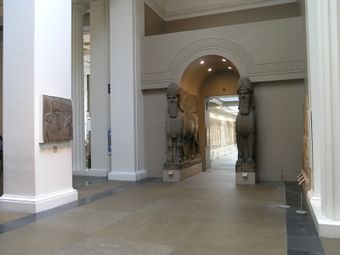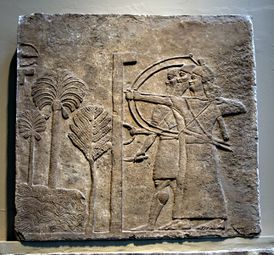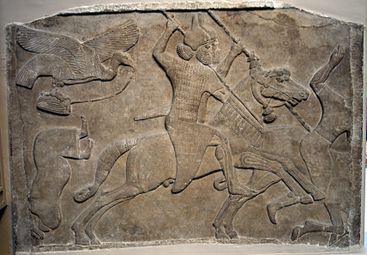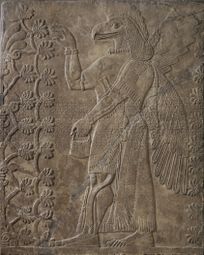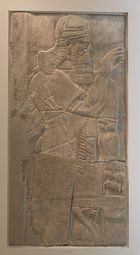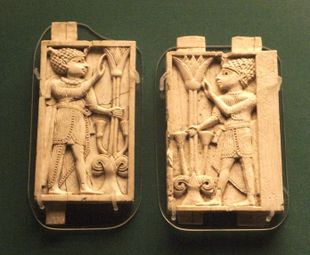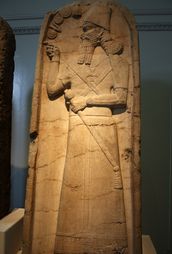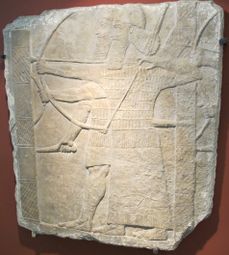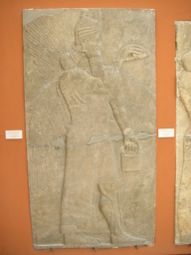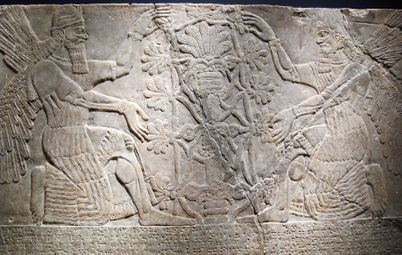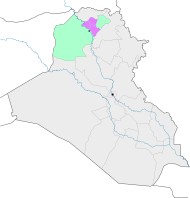كالح
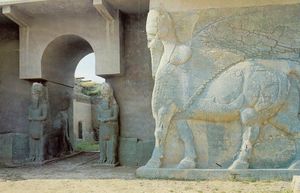 A lamassu at the North West Palace of Ashurnasirpal II before destruction in 2015. | |
| الاسم البديل | Calah, Kalakh, Kalhu |
|---|---|
| المكان | Noomanea, Nineveh Governorate, Iraq |
| المنطقة | Mesopotamia |
| الإحداثيات | 36°5′53.49″N 43°19′43.57″E / 36.0981917°N 43.3287694°E |
| النوع | Settlement |
| المساحة | 3.6 km2 (1.4 sq mi) |
كالح وتعرف كذلك بأسماء أخرى ككالخو وكالخو والنمرود Nimrud، كانت مدينة آشورية، آثارها الباقية تقع 30 كم للجنوب من الموصل في العراق اليوم، أسست كالخو في القرن الثالث عشر قبل الميلاد. وأصبحت في القرن التاسع قبل الميلاد عاصمة الإمبراطورية الآشورية الحديثة زمن الملك آشور ناصربال الثاني، ودمرت في العام 612 ق.م. على يد الكلدانيين والميديين.
الاسم
يرد اسم المدينة في النصوص الآشورية على شكل كالخو، وفي التناخ يرد الاسم بشكل كالخ/ كالح، أما الاسم نمرود فهو على الأرجح تسمية حديثة مستمدة من الشخصية التناخية "نمرود"، فأقدم ذكر لهذه التسمية يعود للرحالة الألماني "كارستن نيبور Carsten Niebuhr" والذي زار موقع المدينة في العام 1766 م.
آثار
Early writings and excavations
تمت أولى عمليات التنقيب في الموقع في العام 1846 م بإدارة الدبلوماسي والآثاري البريطاني "Sir Austen Henry Layard"، وقد كشفت عن بقايا قصر كبير، وتحصينات، كذلك مجموعة كبيرة من المنحوتات من حجر الألبستر، ومشغولات عاجية ومسلات وتماثيل ضخمة. في العام 1955 م. كشفت الحفريات في معبد نبو والتي ادارها الآثاري البريطاني "Sir Max Edgar Lucien Mallowan" عن رقم مسمارية عليها نصوص تحوي عهود الولاء التي قدمها الحكام التابعين في الدولة الآشورية للملوك الآشوريين
Artworks
كالخو الآن
تعاني كالخو في السنوات الماضية من الإهمال، حيث تتعرض الآثار المكشوفة للتعرية بسبب التصحر في المنطقة.[1]
Destruction
Nimrud's various monuments had faced threats from exposure to the harsh elements of the Iraqi climate. Lack of proper protective roofing meant that the ancient reliefs at the site were susceptible to erosion from wind-blown sand and strong seasonal rains.[3]
In mid-2014, the Islamic State of Iraq and the Levant (ISIL) occupied the area surrounding Nimrud. ISIL destroyed other holy sites, including the Mosque of the Prophet Jonah in Mosul. In early 2015, they announced their intention to destroy many ancient artifacts, which they deemed idolatrous or otherwise un-Islamic; they subsequently destroyed thousands of books and manuscripts in Mosul's libraries.[4] In February 2015, ISIL destroyed Akkadian monuments in the Mosul Museum, and on March 5, 2015, Iraq announced that ISIL militants had bulldozed Nimrud and its archaeological site on the basis that they were blasphemous.[5][6][7]
A member of ISIL filmed the destruction, declaring, "These ruins that are behind me, they are idols and statues that people in the past used to worship instead of Allah. The Prophet Muhammed took down idols with his bare hands when he went into Mecca. We were ordered by our prophet to take down idols and destroy them, and the companions of the prophet did this after this time, when they conquered countries."[8] ISIL declared an intention to destroy the restored city gates in Nineveh.[6] ISIL went on to do demolition work at the later Parthian ruined city of Hatra.[9][10] On April 12 2015, an on-line militant video purportedly showed ISIL militants hammering, bulldozing and ultimately using explosive to blow up parts of Nimrud.[11][12]
Gallery
Nimrud ivory plaque, with original gold leaf and paint, depicting a lion devouring a human (British Museum)
Assyrian lion hunt (Pergamon)
Lamassu, Stelas, Statue, Relief Panels, including the Black Obelisk of Shalmaneser III (British Museum)
City under siege (British Museum)
Cavalry battle (British Museum)
Eagle-headed deity (Los Angeles County Museum of Art)
Relief with Winged Genius (Walters Art Museum)
Two Nimrud ivories made in Egypt (British Museum)
Stela of Shamshi-Adad V, Height 195.2 cm, Width 92.5 cm, (British Museum)
Two archers (Hermitage Museum)
Genius and tree of life (Istanbul Museum)
انظر أيضاً
- Cities of the ancient Near East
- Hatra
- Nimrud lens
- Short chronology timeline
- Islamic Iconoclasm
- عاجيات نمرود
المصادر
- ^ Jane Arraf (February 11, 2009). "Iraq: No Haven for Ancient World's Landmarks". The Christian Science Monitor.
- ^ https://www.youtube.com/watch?v=qQAuntNaRWQ
- ^ Jane Arraf (February 11, 2009). "Iraq: No Haven for Ancient World's Landmarks". The Christian Science Monitor.
- ^ "Isis destroys thousands of books and manuscripts in Mosul libraries". The Guardian. 26 Feb 2015.
- ^ Karim Abou Merhi (March 5, 2015). "IS 'bulldozed' ancient Assyrian city of Nimrud, Iraq says". AFP. Retrieved March 5, 2015.
- ^ أ ب "Iraq: Isis militants pledge to destroy remaining archaeological treasures in Nimrud". The Independent. 27 Feb 2015.
- ^ Al Jazeera: ISIL video shows destruction of 7th century artifacts (26 February 2015)
- ^ Morgan Winsor (5 March 2015). "ISIS Destroys Iraqi Archaeological Site Of Nimrud Near Mosul". IBT. Retrieved 8 March 2015.
- ^ "Isis militants continue path of destruction in Hatra by 'demolishing 2,000 year-old ruins'". The Independent. 7 March 2015.
- ^ "Islamic State 'demolishes' ancient Hatra site in Iraq". BBC. 7 March 2015.
- ^ "Islamic State video 'shows destruction of Nimrud'". BBC. 7 March 2015. Retrieved 13 April 2015.
- ^ youtube ISIS destroys Nimrud
وصلات خارجية
- Metropolitan Museum: Digital Reconstruction of the Northwest Palace, Nimrud, Assyria
- Nimrud/Calah
- [1]
- Centro Ricerche Archeologiche e Scavi di Torino excavation site
- Archaeological site photographs at Oriental Institute
- More images from National Geographic
- Treasure of Nimrud rediscovered, article from the Wall Street Journal posted to a message board
- The Secret of Nimrud - Photographs by Noreen Feeney
- Pages using gadget WikiMiniAtlas
- Articles with hatnote templates targeting a nonexistent page
- Missing redirects
- Coordinates on Wikidata
- Pages with empty portal template
- أماكن كانت مأهولة بالسكان في العراق
- محافظة نينوى
- سهل نينوى
- آشور
- مناطق آشورية/سريانية/كلدانية
- Populated places established in the 2nd millennium BC
- مواقع أثرية في العراق
- Ancient Assyrian cities
- Former populated places in Iraq
- مدن التوراة
- Buildings and structures destroyed by ISIL
- Nineveh Governorate
- مدن مدمرة
- نمرود (مدينة)
- 2nd-millennium BC establishments in Assyria
- 7th-century BC disestablishments in Assyria
- Populated places disestablished in the 7th century BC
- مقالات تحتوي مقاطع ڤيديو
- 14th-century BC establishments

